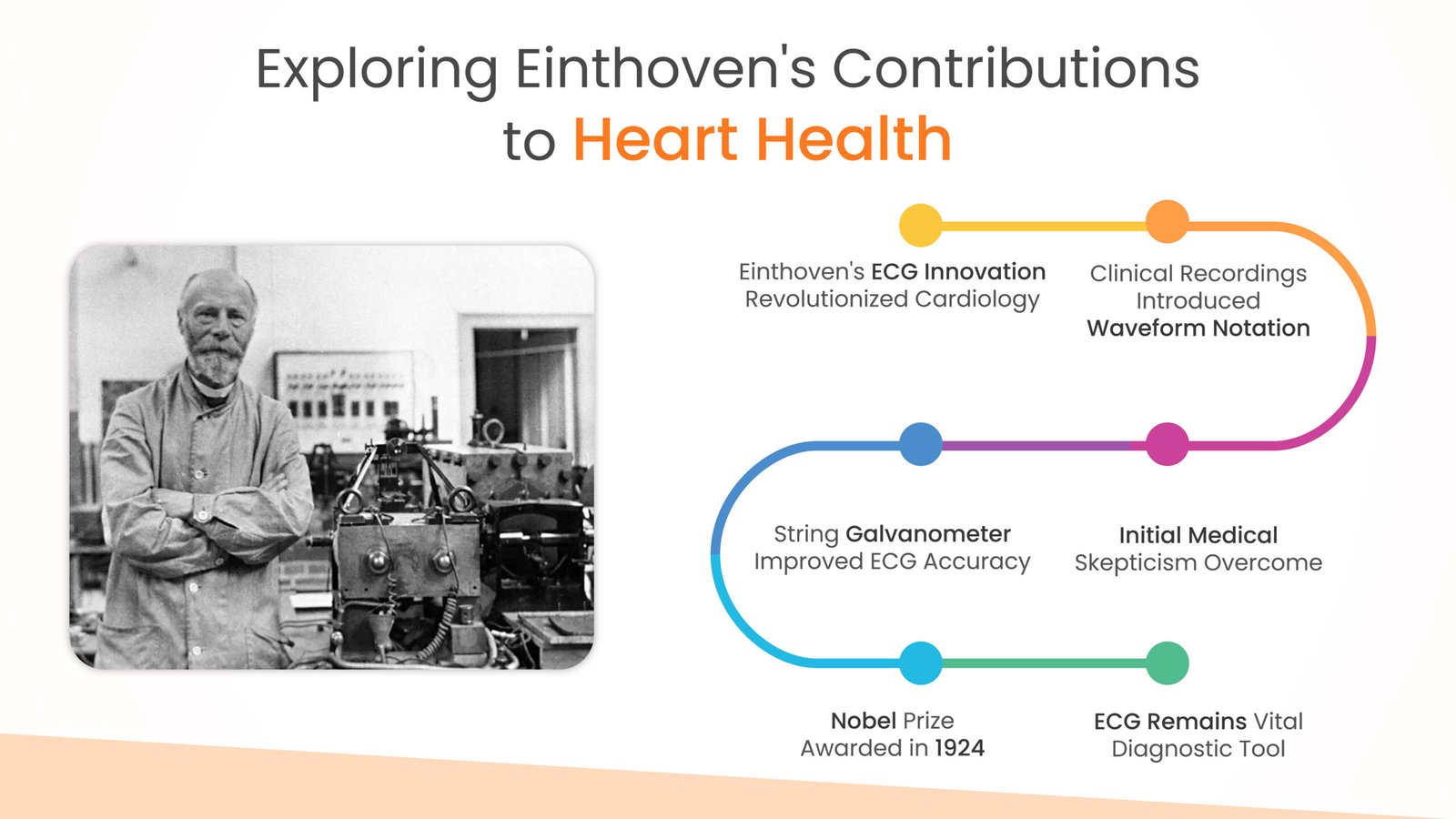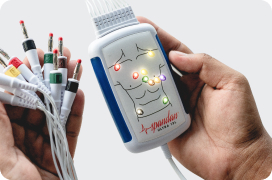
Author:- Mr. Ritesh Sharma
The Dutch scientist Willem Einthoven has made invaluable contributions to the realm of heart health. His impact on the development and refinement of an electrocardiogram (ECG) device cannot be overstated. If you see portable ECG devices today providing you with data on your heart’s electrical activity within a few minutes, then you have this genius of a scientist to thank. While Einthoven did not start from scratch in the invention of an ECG device, he certainly did something revolutionary with the product, making him one of the greatest and most revered scientists in the domain of health tech.
Today, in this blog, we celebrate Einthoven’s contributions to heart health, focusing on his staggering innovation of the ECG device and how it broke new ground in the field of healthcare. ECG, as we know it today, would never be the same without Einthoven’s revolutionary work.
How did Einthoven become interested in the electrical activity of the Heart?
Einthoven’s interest in the electrical activity of the heart stemmed from the demonstration of a crude electrocardiogram device developed by a British physiologist called Augustus Waller. Waller took inspiration for this device from the capillary electrometer, another revolutionary device that detected electric waves of the heart. While Waller’s device was groundbreaking for its time, it did not produce very accurate readings. Hence, Willem Einthoven came into the picture, deciding to make a better device that would record the electrical activity of the heart with utmost accuracy.
Invention of String Galvanometer
Now that Einthoven had inclined toward making a better ECG device than the one made by Waller, he came up with a string galvanometer. This device was quite different from Waller’s crude electrocardiogram device. It consisted of a thin quartz filament coated in silver, enabling it to conduct electrical current from the heart. Einthoven passed the filament between two electromagnets, causing it to move in proportion to the current it was carrying. The filament was a very light substance, making it extremely sensitive. In a 2003 paper, Serge Barold wrote about Einthoven’s work, stating, “Einthoven achieved such amazing technical perfection that many modern electrocardiographs do not attain equally reliable and undistorted recordings”.
Einthoven’s First Clinical Recordings
In 1902, Willem Einthoven made his first clinical recordings. In these recordings, the trace showed a waveform consisting of three peaks and two troughs in each heartbeat. To denote these features, Einthoven used the letters P, Q, R, S, and T, a convention that is followed to this day by healthcare professionals.
After his first clinical recordings, Einthoven was convinced that ECG would be a huge invention in the realm of cardiac care. During his lifespan, Einthoven detected various people, some with a healthy heart and some with heart conditions, such as cardiac arrhythmias of different arrhythmia classifications, heart blocks, and ventricular hypertrophy, i.e., enlarged walls of the heart’s main chambers.
Medical Community’s Skepticism Towards Einthoven’s Innovation
Initially, the medical community was quite skeptical of Einthoven’s innovation of an ECG device. There were doubts about the practical utility of the ECG in diagnosing cardiac conditions, as its interpretation required specialized training and expertise. Some physicians were hesitant to adopt this new technology, preferring instead to rely on traditional diagnostic methods. However, over time, as more research was conducted and the benefits of an ECG device became more apparent, the skepticism of the medical community turned into acceptance.
Einthoven’s innovation revolutionized the field of cardiology, providing clinicians with a powerful tool for diagnosing various cardiac disorders and guiding treatment decisions. For Einthoven’s stupendous contributions to the field of heart health, he was awarded a Nobel Prize in medicine in 1924.
Einthoven Revolutionized ECG Forever
Today, ECG is the standard screening procedure for heart palpitations or more dangerous conditions such as heart attacks. However, without Einthoven innovating the device, none of this would be possible. ECG has been prevalent in healthcare for more than 100 years now, and it still stands as a mandatory screening tool for individuals with any kind of heart abnormalities. The history of ECG is fascinating, and Einthoven’s name is etched in it forever. From a 600-pound ECG device to a 12-14 gram portable ECG device, we have come so far, but Einthoven’s contributions to heart health remain extremely valuable to this day.
So, if you can detect your heart abnormalities from arrhythmias such as tachycardia and bradycardia to different heart dysfunctions, you have no one but Willem Einthoven to thank. He has paved the way for an ECG device to continually thrive in the domain of healthcare.
Einthoven’s ECG remains an indispensable tool in cardiology clinics and hospitals worldwide, saving countless lives by aiding in the early detection and management of heart disease. His contributions have had a lasting impact on heart health, shaping the way cardiovascular conditions are diagnosed, monitored, and treated.
In conclusion, Willem Einthoven’s pioneering research and inventions have had a profound and enduring impact on heart health. His legacy continues to inspire advancements in cardiology, shaping the way heart disease is understood, diagnosed, and treated in the modern era.
Einthoven's Legacy in Modern Cardiology
Apart from the invention of an ECG device, Einthoven has had many more contributions to the domain of heart health and cardiology. His immaculate research and innovative thinking paved the way for several achievements in the field of cardiology. He influenced how heart-related conditions are diagnosed, treated, and understood today.
One significant aspect of Einthoven’s work is his contribution to the understanding of cardiac arrhythmias. By meticulously studying the electrical activity of the heart and developing methods to accurately record and interpret ECG waveforms, Einthoven provided clinicians with invaluable insights into different types of arrhythmias. Today, his classification system for ECG waveforms remains fundamental in diagnosing and categorizing various arrhythmias, guiding treatment decisions for patients worldwide.
Furthermore, Einthoven’s emphasis on precision and accuracy in ECG recordings set a standard for medical instrumentation and paved the way for the development of more sophisticated electrocardiographic technologies. His string galvanometer, though revolutionary for its time, served as a foundation for subsequent innovations in ECG device design, leading to the creation of more portable, user-friendly, and precise devices that are now commonplace in clinical settings.
As we reflect on Willem Einthoven’s remarkable achievements and enduring legacy, we are reminded of the profound impact that a single individual can have on the course of medical history. His pioneering spirit, visionary insights, and unwavering dedication to advancing the frontiers of knowledge continue to inspire generations of scientists, clinicians, and innovators, shaping the future of cardiovascular medicine and improving the lives of countless individuals worldwide.
In conclusion, Willem Einthoven’s contributions to heart health transcend the boundaries of time and discipline, leaving an indelible mark on the field of cardiology and inspiring generations of researchers and clinicians to push the boundaries of scientific knowledge and medical practice. His legacy serves as a beacon of inspiration for all who strive to make meaningful contributions to the advancement of human health and well-being.




